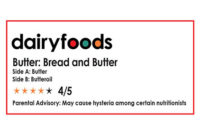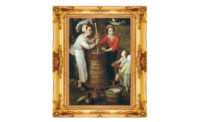State of the industry 2015: Demand drives butter prices higher

Photo courtesy of Darigold







Sponsored by:

Everybody loves cream and butter. And now they have science on their side. Health studies are finding that maybe dairy fat isn’t so bad.
Fluid processors are selling more whole milk, which takes cream. Manufacturers of cheese and yogurt are developing more full-fat varieties. Ice cream makers, naturally, demand cream, and makers of premium products need even more of it.
What’s left after those dairy processors buy what they need is then churned into butter, which is sold domestically or exported. An estimated 20% of available milk fat is used to manufacture butter.
Butter production has fallen pretty much every month since the beginning of the year. In January, butter churners made about 179.6 million pounds, according to the National Agricultural Statistics Service. In August, they made 128.6 million pounds. Looking at year-over-year comparisons, butter production was steady. According to the September Dairy Market Report, processors made 445 million pounds of butter from May to July 2015, and 444 million pounds in the same period in 2014. The Dairy Market Report is published by Dairy Management Inc. and the National Milk Producers Federation.
Weekly CME prices rose every week from the beginning of the year until early October. On Jan. 3, the price for a pound of butter was $1.55. The price peaked at $2.97 on Sept. 26 and fell to $2.37 on Oct. 10. No observers believed a $3 butter price was sustainable, said NMPF economist Peter Vitaliano.
Retail butter prices rose an average of 43 cents in the 52 weeks ended Aug. 9, 2015, according to Chicago research firm IRI. Higher prices in butter (compared to other dairy products) don’t seem to scare away shoppers, said Vitaliano, NMPF’s vice president of economic policy and market research. Indeed, unit sales of butter increased about 2% in the last year, according to IRI. But thanks to the price increase, dollars sales jumped nearly 16%.
Minnesota-based dairy cooperative Land O’Lakes has the top branded butter sold at retail, followed by Challenge Butter, a brand of California Dairies Inc., another cooperative. Both brands rolled out new products this year.
In August, Land O’Lakes, Arden Hills, Minn., came out with Land O Lakes European Style Butter made with sweet cream in salted and unsalted varieties. It has an 82% fat content (compared to 80% found in typical U.S. butters). The co-op noted that European-style super-premium butters comprise about 1% of the entire market volume, but sales are rising quickly and the category is growing.
The butter is sold in half-pound boxes, with two individually wrapped 4-ounce sticks. The suggested retail price is $3.79.
Challenge Dairy Products, Dublin, Calif., is making a lactose-free spreadable butter with canola oil. The dairy noted in a press release that 10% of the population is lactose-intolerant. A clarification process removes the milk solids or lactose, according to the company. Then the clarified butter is blended with canola oil. The product became available at national retailers in June. It’s sold in 15-ounce tubs for an average retail price of $4.49.
In September, Credit Suisse released a report titled “Fat: the new health paradigm.” It concludes that in the United States, “butter should grow faster as the market learns the benefits of eating butter and the negative perception linked to saturated fats gradually disappears.”
For that to happen, dairy farmers are going to have to increase milk supply and butter churners are going to have to fight other dairy processors for the supply of cream.
52 weeks ended Aug. 9, 2015. Total U.S. Multi-Outlet w/ C-Store (Supermarkets, Drugstores, Mass Market Retailers, Gas/C-Stores, Military Commissaries and Select Club & Dollar Retail Chains). Source: IRI, Chicagp
Milk | Cheese | Cultured | Ice Cream | Butter | Non-dairy Beverages | Ingredients | Exports
Looking for a reprint of this article?
From high-res PDFs to custom plaques, order your copy today!










